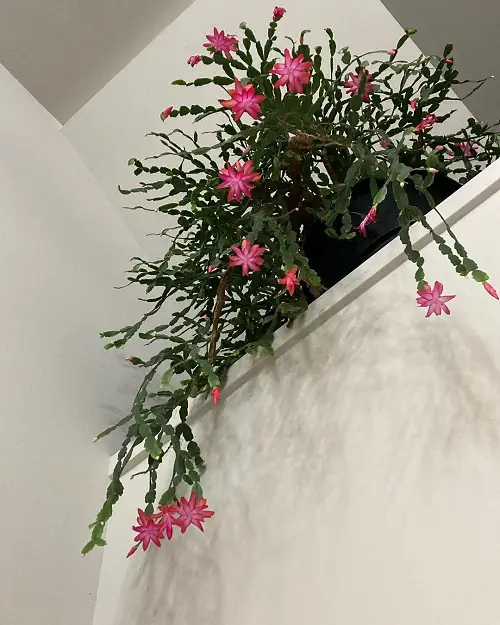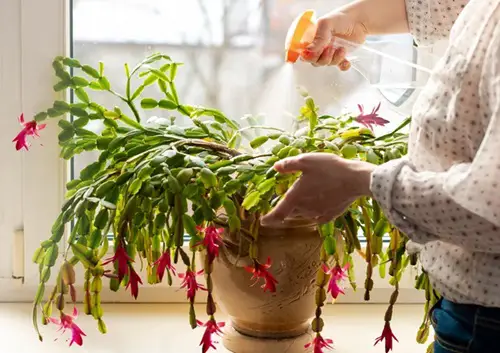Here are secret Tricks to Force your Christmas Cactus to Bloom Early as the holiday season begins after Thanksgiving. Don’t miss out!

When it comes to this festive succulent, the time when it blooms is everything! With deep green cascading segments and bright pink and scarlet flowers, here are tricks to force it to bloom early, from late fall in Thanksgiving through Christmas and New Year!
Can You Make Your Christmas Cactus Bloom Early?
The short answer is yes! Tricking this forest cactus into blooming early involves manipulating its growing environment—primarily temperature, light, and water.
As an epiphyte from Brazil, it usually blooms in May in its natural habitat in the Southern Hemisphere, which sees rainy, dark, and cool days for at least 6-8 weeks around that time. Mimic these conditions at your preferred time, and you can coax your Schlumbergera into blooming well in time for the December holidays or even earlier!
Tricks To Force Your Christmas Cactus To Bloom Early
1. Give it Long, Dark Nights
As a short-day plant, Christmas cactus needs 12-16 hours of complete darkness daily for about six weeks to bloom. Not a single ray of light should reach your plant during its dark period. This is essential for the plant to go dormant, after which it can form buds.
Keep it inside a cupboard or dark room for at least 13 hours, and then, after the blackout hours, expose it to bright, filtered sunshine by placing it on an east-facing window or so. Repeat this cycle daily as it would in its natural habitat. Here’s when to do it, but start doing it a bit earlier.
2. Keep it Cool
Place it on a plant stand to easily move your potted Christmas cactus to spots with the right light and temperatures. During this short-day long-night period, keep temperatures at about 50-60 F (10-15 C). Keep it sheltered from air conditioning vents, strong winds, and temps below 50 F (10 C).
Note that this tropical succulent is highly sensitive to fluctuations, so keep the coolness steady and consistent during its dormancy. Once you see buds forming, you can slowly increase warmth to about 60-65 F (15-18 C).
3. Switch to a Phosphorus-rich Fertilizer
While you may have been feeding your Christmas cactus a balanced 20-20-20 fertilizer monthly during its growth phase, switch things up when it’s going toward bloom time! As late summer arrives, pick a fertilizer with an NPK (nitrogen-phosphorus-potassium) ratio of 0-15-10.
A nitrogen-free, phosphorus-rich fertilizer will help the plant refocus its energy on flowering rather than foliage. Check out these bloom-boosting fertilizer recipes. But do not fertilize at all during dormancy after the mid-fall.
4. Induce Drought Stress
Though Christmas cacti are native to rainforests, pull back on watering at the start of fall, around October. Water moderately during this dormancy period, typically when the topsoil feels dry to the touch.
While you cut back on watering, it’s always a good idea to provide it with some humidity to mimic natural conditions.
5. Work Backward from Bloom Time

Whether you want your Christmas cactus to bloom in the fall or during Christmas, set a tentative date. Around 6-8 weeks before this date, start creating conditions for the dormancy period.
Of course, the foremost thing to ensure for flowering is the blackout period. Combine it with lower temperatures and reduced watering, as mentioned above.
Things to Remember When Growing Christmas Cactus
- During the dormancy period, continue watering your Christmas cactus every 2-3 weeks when the soil is dry to the touch while it blooms. Cutting off watering completely will cause the buds and flowers to drop.
- While the classic Christmas cactus produces red flowers, you may get hybrids to bloom with pink, white, magenta, and lavender flowers.
- Throughout the year, except for blooming season, keep your cactus in a spot where it receives bright, indirect light. The occasional morning sun is perfect, but too much direct sunlight, especially in the afternoon, will damage it.
- The best soil for Christmas Cactus is a cactus or succulent mix as it is well-draining, exactly like this plant prefers. When using an all-purpose soil mix, ensure you water less than usual, as this type retains more moisture.
Have you tried to get your Christmas cactus to bloom earlier yet? If so, let us know how it went in the comments below!




